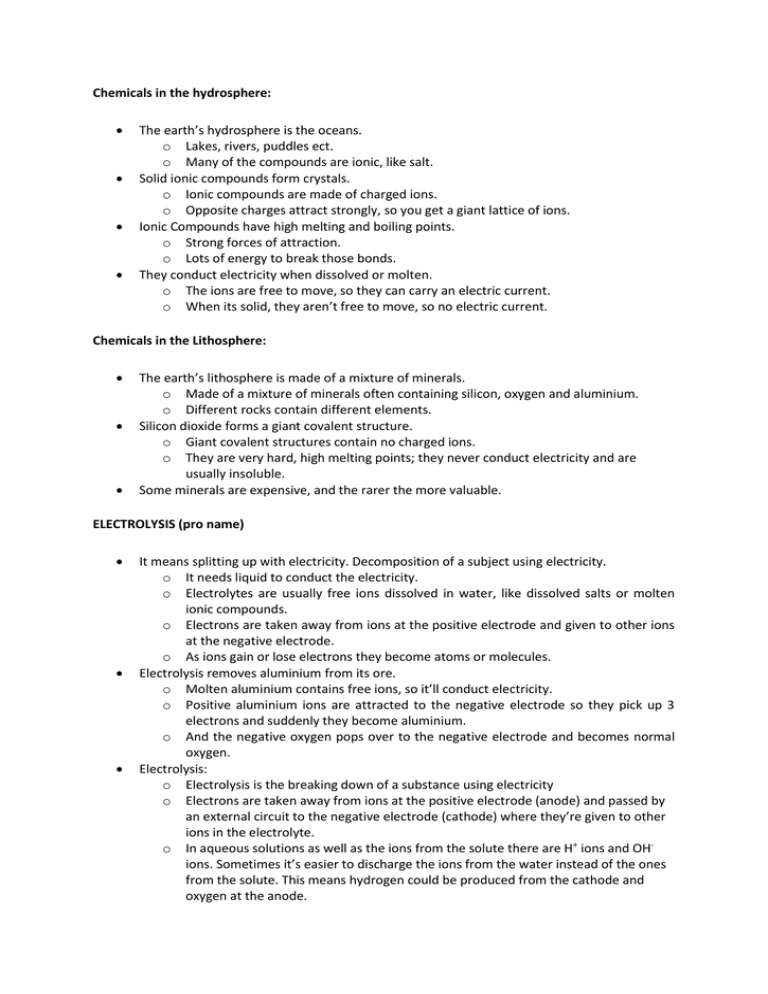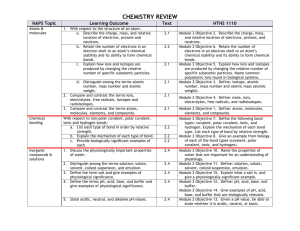File
advertisement

Chemicals in the hydrosphere: The earth’s hydrosphere is the oceans. o Lakes, rivers, puddles ect. o Many of the compounds are ionic, like salt. Solid ionic compounds form crystals. o Ionic compounds are made of charged ions. o Opposite charges attract strongly, so you get a giant lattice of ions. Ionic Compounds have high melting and boiling points. o Strong forces of attraction. o Lots of energy to break those bonds. They conduct electricity when dissolved or molten. o The ions are free to move, so they can carry an electric current. o When its solid, they aren’t free to move, so no electric current. Chemicals in the Lithosphere: The earth’s lithosphere is made of a mixture of minerals. o Made of a mixture of minerals often containing silicon, oxygen and aluminium. o Different rocks contain different elements. Silicon dioxide forms a giant covalent structure. o Giant covalent structures contain no charged ions. o They are very hard, high melting points; they never conduct electricity and are usually insoluble. Some minerals are expensive, and the rarer the more valuable. ELECTROLYSIS (pro name) It means splitting up with electricity. Decomposition of a subject using electricity. o It needs liquid to conduct the electricity. o Electrolytes are usually free ions dissolved in water, like dissolved salts or molten ionic compounds. o Electrons are taken away from ions at the positive electrode and given to other ions at the negative electrode. o As ions gain or lose electrons they become atoms or molecules. Electrolysis removes aluminium from its ore. o Molten aluminium contains free ions, so it’ll conduct electricity. o Positive aluminium ions are attracted to the negative electrode so they pick up 3 electrons and suddenly they become aluminium. o And the negative oxygen pops over to the negative electrode and becomes normal oxygen. Electrolysis: o Electrolysis is the breaking down of a substance using electricity o Electrons are taken away from ions at the positive electrode (anode) and passed by an external circuit to the negative electrode (cathode) where they’re given to other ions in the electrolyte. o In aqueous solutions as well as the ions from the solute there are H+ ions and OHions. Sometimes it’s easier to discharge the ions from the water instead of the ones from the solute. This means hydrogen could be produced from the cathode and oxygen at the anode. o In molten salts there is only one source of ions. Positive metal cations are reduced (they gain electrons) to atoms at the cathode. Negative anions are oxidised (they lose electrons) to atoms at the anode. Molten Product Half-equation Product Half-equation electrolyte produced at at cathode produced at at anode cathode anode Lead iodide Lead Pb2+ + 2e- -> Pb Iodine 2I- -> I2 +2ePotassium Potassium K+ + e- -> K Chlorine 2Cl- -> Cl2 + 2echloride Aluminium aluminium Al3+ + 3e- -> Al Oxygen 2O2- -> O2 + 4eoxide o o o Electrodes can also lose or gain mass. E.g. Copper: When a certain number of electrons flow away from the positive electrode the same number of electrons must flow onto the negative electrode Looking at the negative electrode half-equation (Cu2+ + 2e- -> Cu) 1 mole of copper ions picks ip 2 moles of electrons. This makes 1 mole of copper atoms, which sticks to the electrode, causing an increase in mass. The positive electrode half-equation (Cu -> Cu2+ + 2e- ) shows that 1 mole of copper atoms, loses 2 moles of electrons and is released as copper ions into the solution. Copper is lost from the electrode, so there is a decrease in mass. So, 1 mole of copper is added to the negative electrode as 1 mole is lost from the anode. This means the gain in mass is equal to the loss in mass. Diamond: Diamonds are sparkly, colourless and clear. – ideal for jewellery Each carbon atom forms four covalent bonds in a very rigid giant covalent structure, which makes diamond really hard. – ideal for cutting tools As there are many strong covalent bonds they give diamond a very high melting point Diamond does not conduct electricity because it has no free electrons. Graphite: Is black, opaque and kind of shiny Each carbon atom only forms three covalent bonds, creating sheets of carbon atoms which are free to slide over each other. The layers are held together so loosely that they can be rubbed off onto paper to leave a black mark- how a pencil works. This also makes graphite slippery and so it’s an ideal lubricating material. Graphite has got a high melting point as the covalent bonds need loads of energy to break. Since only three out of each carbon’s four bonds are used in bonds, there are lots of spare electrons. This means that graphite conducts electricity- it is used for electrodes in electrolysis. IONIC BONDING COVALENT BONDING e.g. NaCl, KCl- any salt e.g. O2, Cl2, HCl Gives and takes electrons Shares electrons Metals and non metals Just metals Can conduct electricity when molten or dissolved Cannot conduct electricity Large latticed molecules Small simple molecules High melting points Low melting points Soluble in water and boiling and boiling Insoluble in water • Ionic: gives and takes electrons, dissolves, can conduct electricity when molten • Covalent: shares electrons, insoluble, cannot conduct electricity (graphite is an exception) • Diamond is in a giant covalent structure so there are no electrons free to move and conduct electricity. However graphite has one free electron not covalently bonded so it can move around and conduct electricity. • • • • • Water covalently bonds and sodium chloride ionically bonds NaCl has a much higher melting and boiling points NaCl conducts electricity when molten Sodium chloride has a giant ionic lattice- Water has a small covalent structure Water liquid at room temperature- NaCl solid at room temperature




